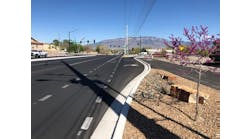It is no secret that the city of Toronto, like many mature cities, is constantly faced with replacing aging infrastructure in older neighborhoods.
Since these neighborhoods were built, there have been incremental changes, such as new infill development with larger houses, wider driveways and new sidewalks. Road reconstruction is a significant infrastructure problem, particularly in older cities. Growing populations stress these physical support systems, along with natural disasters and accidents, causing their life cycle to be shortened considerably. Even climate change is a major factor that no longer can be ignored.
In Canada, a number of major urban centers are now facing the challenge of managing their aging roadways. Toronto is among those faced with upgrading its mature street systems to service increasing demands. An example of the complexity of the issues faced in the city’s infrastructure-replacement program is the Brycemoor Road-Brownfield Gardens street system. It was apparent, due to the deterioration and structural issues of the road, that the lack of overland drainage for extreme storms required an unaffordable upsizing of the storm system. As a result of distinct questions related to timing, subsurface and surface flows, and flooding on key locations of the roadways, it was obvious a simplified analysis method could not be applied. To understand the flooding and overland flow issues on the street system of Brycemoor Road-Brownfield Gardens in the city of Toronto, it was concluded a detailed modeling analysis using PCSWMM would be required.
Modeling poses advantages
The Brycemoor Road-Brownfield Gardens street system is located in the district of Scarborough within the city of Toronto. The roads service a predominantly residential development, consisting of mature single-detached homes. For both roads, under existing conditions, there are areas that have the potential for flooding to occur due to a series of open ditches along the sides of Brownfield Gardens, as well as the limited capacity of the existing sewer system.
The approach developed for analyzing the flooding concerns in the Brycemoor-Brownfield Garden street system consisted of comparing the impacts of the proposed design to existing circumstances. The intended outcome of the modeling study was to guide the design solution proposed to mitigate existing flooding issues. In addition, it was intended to understand the downstream impacts particularly at a 300-mm storm sewer under the school site.
Design criteria
Specific design criteria were outlined by the city of Toronto. It was specified that the design should be optimized to municipal standards. For a storm-sewer system, it is required that the design provides capacity for the two-year storm within the minor system.
It was indicated by the city that there were a few key areas on the road that were of significant concern as they were reverse-slope driveways. It was emphasized that a proposed design solution could not consist of low points in the road being located in front of the lots with reverse-slope driveways, as basement flooding is a significant concern. There are three reverse-slope driveways located on Brownfield Gardens at 419, 420 and 444. Flooding cannot occur in the vicinity of these driveways and should be demonstrated for a range of storm events.
Modeling scenarios
The Brycemoor Road and Brownfield Gardens currently drains to the south through an existing public-school site. The minor system flows are captured by a 375-mm-diam. sewer and conveyed to a 300-mm-diam. sewer under the school site. Overland drainage from the site is captured in a series of open ditches along the sides of Brownfield Gardens. Brycemoor Road is a relatively steep grade and drainage from it is conveyed to Brownfield Gardens.
In the proposed design, there exist low points in front of lots 438 and 432. This scenario also proposes that the centerline of the road in front of 420 and 419 Brownfield Gardens will have a crown that directs flows toward a double-inlet catch basin placed in front of 419. The proposed sewer will have a diameter of 600 mm. The existing 375-mm-diam. sewer will remain in place to handle any overflow the proposed sewer is unable to manage.
The modeling analysis carried out was to assess the water-surface elevations for the 2- to 100-year and regional design storm events, as well as the extreme storm event that took place on Aug. 19, 2005, in Ontario.
The road elevations at these key areas of interest for each scenario are shown in Table 1.
A dynamic drainage analysis was completed using the urban drainage modeling software PCSWMM. This modeling tool was used due to its ability to effectively integrate hydrologic processes with hydraulic analysis in one platform. In addition, it provides a means to gain a comprehensive understanding of the flows within the area of study as well as the location of discharge.
Hydrologic conditions were modeled based on data obtained from the city. Subcatchment parameters such as drainage areas, slopes, % imperviousness, infiltration and Manning’s n were taken from the base plan, surveys and site walks. The drainage areas were further discretized in the PCSWMM model. The hydraulic details of the model were developed based on the proposed design, site walks and CCTV investigation.
Increasing in size
PCSWMM simulations for the 2- to 100-year, regional and Aug. 19, 2005, storm events established water-surface elevations at the key areas of interest along Brycemoor Road and Brownfield Gardens. Table 2 provides the water elevations at these areas for this proposed design.
The results from the modeling analysis indicate that enlarging the sewer along Brycemoor Road and Brownfield Gardens to a 600 mm diameter, designed to the city of Toronto’s standard for the two-year storm, will alleviate the flooding risks along Brownfield Gardens. The results further demonstrate that the proposed design, when combined with the existing 375-mm sewer, will mitigate any flooding risks at the three reverse-slope driveways located on Brownfield Gardens at 419, 420 and 444.
The storm profiles shown in Figures 1 and 2 generated for the existing 375-mm sewer demonstrate the magnitude of the flooding risk along Brownfield Gardens. Examination of the Hydraulic Grade Line (HGL) of the two-year storm (Figure 1) indicates the sewer is at full capacity, resulting in water backing up to the intersection of Brownfield Gardens and Brycemoor Road. Due to the inability for the existing sewer to handle the two-year storm, overtopping of the manhole at this location causes additional overland flow down Brownfield Gardens, initiating high water elevations near the reverse driveways.
Beyond the two-year storm, as shown in the storm profile for the regional storm event (Figure 2), flooding occurs at the catch basins near these driveways in addition to the surcharging that occurs at the intersection of the Brownfield Gardens and Brycemoor Road street system.
Comparing the water elevations to the road elevations at each reverse driveway, it is shown that no flooding should occur for all storm events simulated. Examining the two-year storm profile for the proposed design, it is seen that the increased sewer size of 600 mm provides the necessary capacity required upstream of the existing 300-mm sewer downstream to ensure that no surcharging occurs along Brownfield Gardens. In addition, enlarging the sewer to 600 mm ensures that there are no impacts downstream on the 300-mm sewer. The existing conditions profiles show the HGL of the 300-mm sewer rising as the storm becomes larger. In the proposed design solution, the HGL of the 300-mm sewer is maintained for increasing storms, thereby confirming there are no adverse effects on the downstream system.
In addition, the proposed design solution intends to maintain the existing 375-mm sewer to provide further storage in larger storms such as the regional and Aug. 19, 2005, storms. The benefit of this added mitigation feature is demonstrated in these larger storm profiles where a drop in the water level in the sewer is seen at the catch basin just upstream of Lot 444. The results show that the proposed design solution provides more than adequate flooding protection for storms greater than the five-year.
The Brycemoor Road and Brownfield Garden street system is an example of the complex issues the city of Toronto has been facing with aging roadway infrastructure. While many factors, such as increased development and climate change, have intensified this problem, the replacement program that has been established is working hard to mitigate these issues. Detailed modeling analysis, such as the one presented in this article, can be applied in these complex scenarios to gain a deeper understanding of aging storm-water infrastructure problems and offer appropriate, cost-effective solutions. It is expected the city of Toronto will undergo a number of these projects over the next several years, where detailed modeling analysis such as this will be applied in the design process. R&B


